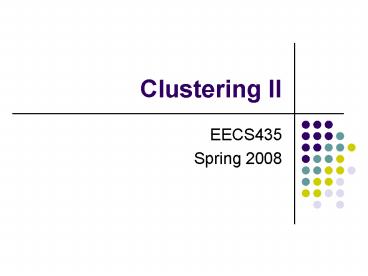Clustering II - PowerPoint PPT Presentation
1 / 25
Title: Clustering II
1
Clustering II
- EECS435
- Spring 2008
2
Partitioning Methods
- We have studied
- k-means
- k-mediods
- PAM
- CLARA
- CLARANS
- O(knt)
- Need to specify k
- Doesnt support complex cluster structure
3
Hierarchical Clustering
- Group data objects into a tree of clusters
4
AGNES (Agglomerative Nesting)
- Initially, each object is a cluster
- Step-by-step cluster merging, until all objects
form a cluster - Single-link approach
- Each cluster is represented by all of the objects
in the cluster - The similarity between two clusters is measured
by the similarity of the closest pair of data
points belonging to different clusters
5
Dendrogram
- Show how to merge clusters hierarchically
- Decompose data objects into a multi-level nested
partitioning (a tree of clusters) - A clustering of the data objects cutting the
dendrogram at the desired level - Each connected component forms a cluster
6
DIANA (DIvisive ANAlysis)
- Initially, all objects are in one cluster
- Step-by-step splitting clusters until each
cluster contains only one object
7
Distance Measures
- Minimum distance
- Maximum distance
- Mean distance
- Average distance
m mean for a cluster C a cluster n the number
of objects in a cluster
8
Challenges of Hierarchical Clustering Methods
- Hard to choose merge/split points
- Never undo merging/splitting
- Merging/splitting decisions are critical
- Do not scale well O(n2)
- What is the bottleneck when the data cant fit in
memory? - Integrating hierarchical clustering with other
techniques - BIRCH, CURE, CHAMELEON, ROCK
9
BIRCH
- Balanced Iterative Reducing and Clustering using
Hierarchies - CF (Clustering Feature) tree a hierarchical data
structure summarizing object info - Clustering objects ? clustering leaf nodes of the
CF tree
10
Clustering Feature Vector
Clustering Feature CF (N, LS, SS) N Number
of data points LS ?Ni1Xi SS ?Ni1Xi2
11
CF-tree in BIRCH
- Clustering feature
- Summarize the statistics for a subcluster the
0th, 1st and 2nd moments of the subcluster - Register crucial measurements for computing
cluster and utilize storage efficiently - A CF tree a height-balanced tree storing the
clustering features for a hierarchical clustering
- A nonleaf node in a tree has descendants or
children - The nonleaf nodes store sums of the CFs of
children
12
CF Tree
Root
B 7 L 6
Non-leaf node
CF1
CF3
CF2
CF5
child1
child3
child2
child5
Leaf node
Leaf node
CF1
CF2
CF6
prev
next
CF1
CF2
CF4
prev
next
13
Parameters of A CF-tree
- Branching factor the maximum number of children
- Threshold max diameter of sub-clusters stored at
the leaf nodes
14
BIRCH Clustering
- Phase 1 scan DB to build an initial in-memory CF
tree (a multi-level compression of the data that
tries to preserve the inherent clustering
structure of the data) - Phase 2 use an arbitrary clustering algorithm to
cluster the leaf nodes of the CF-tree
15
Pros Cons of BIRCH
- Linear scalability
- Good clustering with a single scan
- Quality can be further improved by a few
additional scans - Can handle only numeric data
- Sensitive to the order of the data records
16
Drawbacks of Square Error Based Methods
- One representative per cluster
- Good only for convex shaped having similar size
and density - A number of clusters parameter k
- Good only if k can be reasonably estimated
17
CURE the Ideas
- Each cluster has c representatives
- Choose c well scattered points in the cluster
- Shrink them towards the mean of the cluster by a
fraction of ? - The representatives capture the physical shape
and geometry of the cluster - Merge the closest two clusters
- Distance of two clusters the distance between
the two closest representatives
18
Drawback of Distance-based Methods
- Hard to find clusters with irregular shapes
- Hard to specify the number of clusters
- Heuristic a cluster must be dense
19
Directly Density Reachable
- Parameters
- Eps Maximum radius of the neighborhood
- MinPts Minimum number of points in an
Eps-neighborhood of that point - NEps(p) q dist(p,q) ?Eps
- Core object p Neps(p)?MinPts
- Point q directly density-reachable from p iff q
?Neps(p) and p is a core object
MinPts 3 Eps 1 cm
20
Density-Based Clustering Background (II)
- Density-reachable
- Directly density reachable p1?p2, p2?p3, , pn-1?
pn ? pn density-reachable from p1 - Density-connected
- Points p, q are density-reachable from o ? p and
q are density-connected
21
DBSCAN
- A cluster a maximal set of density-connected
points - Discover clusters of arbitrary shape in spatial
databases with noise
22
DBSCAN the Algorithm
- Arbitrary select a point p
- Retrieve all points density-reachable from p wrt
Eps and MinPts - If p is a core point, a cluster is formed
- If p is a border point, no points are
density-reachable from p and DBSCAN visits the
next point of the database - Continue the process until all of the points have
been processed
23
Problems of DBSCAN
- Different clusters may have very different
densities - Clusters may be in hierarchies
24
OPTICS A Cluster-ordering Method
- OPTICS ordering points to identify the
clustering structure - Group points by density connectivity
- Hierarchies of clusters
- Visualize clusters and the hierarchy
25
DENCLUE Using Density Functions
- DENsity-based CLUstEring
- Major features
- Solid mathematical foundation
- Good for data sets with large amounts of noise
- Allow a compact mathematical description of
arbitrarily shaped clusters in high-dimensional
data sets - Significantly faster than existing algorithms
(faster than DBSCAN by a factor of up to 45) - But need a large number of parameters































